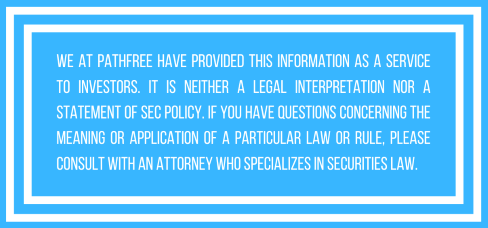

Investment Insights
The healthcare industry plays a critical role in our society by providing medical care and support to individuals in need. With the global population growing and aging, the demand for healthcare services and products is increasing. As a result, the industry is experiencing significant growth, presenting a wealth of opportunities for innovative companies like PathFree Technologies Corporation to contribute to its development.
PathFree Technologies Corporation is an innovator in medical device manufacturing, developing cutting-edge medical devices that are affordable, accessible, and user-friendly. The company’s multiple patented devices have the potential to change the landscape of the medical field, improving the quality of life for patients worldwide.
By investing in PathFree Expansion LLC, investors have the opportunity to participate in the growth potential of the healthcare industry and the innovative products that PathFree Technologies Corporation has to offer. The Reg D 506c Security offers convertible common units that entitle unit holders to 50% of the Company’s profit annually for a period of 5 years, with conservative projections suggesting a low-end annual return of 57%. These returns are paid out quarterly and come with the option of receiving a return of capital or converting the convertible common units into equity shares in PathFree Technologies Corporation on a 1 for 1 basis.
In addition to generating financial returns for investors, investing in PathFree Expansion LLC contributes to a company that is changing the face of the medical industry. PathFree Technologies Corporation is committed to improving the lives of individuals worldwide by developing innovative medical devices that save lives.
Overall, PathFree Technologies Corporation has the potential to make a significant impact on the healthcare industry, and investing in the company through PathFree Expansion LLC presents an exciting opportunity to be a part of that growth and development.
Industry Overview
The medical device industry is constantly evolving, and there are many companies that have gone public or been acquired, making it difficult to keep track of all of them. Additionally, providing comprehensive details for each company would require a significant amount of research and analysis.
However, you can find information on medical device companies that have gone public or been acquired by searching for news articles and reports from reputable sources such as the Wall Street Journal, Bloomberg, and the Financial Times. You can also check industry reports and databases from sources such as Evaluate MedTech, FierceBiotech, and MedCity News for information on companies in the medical device industry.

Some examples of medical device companies that have recently gone public or been acquired include:
Acquisitions:
- Stryker Corporation’s acquisition of Wright Medical Group N.V. for $5.4 billion in 2020.
- Philips’ acquisition of BioTelemetry for $2.8 billion in 2021.
- Zimmer Biomet’s acquisition of A&E Medical Corporation for an undisclosed amount in 2021.
- Boston Scientific’s acquisition of BTG plc for $4.2 billion in 2019.
- Medtronic’s acquisition of Mazor Robotics for $1.7 billion in 2018.
- Abbott Laboratories’ acquisition of St. Jude Medical for $25 billion in 2017.
- Johnson & Johnson’s acquisition of Auris Health for $3.4 billion in 2019.
- ResMed’s acquisition of Propeller Health for $225 million in 2018.
- Smith & Nephew’s acquisition of Osiris Therapeutics for $660 million in 2019.
- Baxter International’s acquisition of Cheetah Medical for $230 million in 2019.
IPOs:
- Inspire Medical Systems’ IPO in 2018.
- Shockwave Medical’s IPO in 2019.
- Silk Road Medical’s IPO in 2019.
- TransMedics’ IPO in 2018.
- Tandem Diabetes Care’s IPO in 2013.
- Senseonics’ IPO in 2016.
- Inari Medical’s IPO in 2020.
- Dexcom’s IPO in 2005.
- Intuitive Surgical’s IPO in 2000.
- Nevro’s IPO in 2014.
Please note that this list is not comprehensive and there may be other medical device companies that have recently gone public or been acquired. Also, the information presented may be subject to change over time, and it is important to verify the accuracy and relevance of the data before making any investment decisions.
What are the characteristics of a good investment opportunity?
We all know investing is crucial to build wealth, to lead a comfortable life in the future. There are many different ways you can invest, but not all of those are good—the traits of a good investment opportunity separate from a poor choice.
On this page we will discuss some of the traits of a good investment opportunity that will help you avoid disappointment. Using the input as a checklist, you will be able to avoid investments with a high chance of failure and select the ones that would earn you a fortune.
Why should you invest?
Investing is the simplest way to reach your financial goal and attain financial freedom. With the interest rates rising in the current situation and inflation growing, putting money in saving schemes can’t keep pace with rising prices or the declining value of money. For this reason, everyone must consider undertaking some risks via a diversified investment portfolio.
But the investment world is treacherous water. There are numerous alternatives available for investing, but not all are equally good, and before you realise it will bleed you dry. As more investment options are opening before investors, they need to be careful about choosing the option to line the purse. Understanding the differences between good and bad investments, therefore, makes a critical study.
Let’s discuss what a good investment is and what separates a good investment from a bad one.
What is a good investment?
When we talk about good and bad investment, a question naturally comes to our mind: What is a good investment? There are several characteristics of a good investment opportunity that separate it from the other available choices. One such factor is risk and return.
The amount of risk on your portfolio should be limited. Periodic volatility and losses are typical in investment, but the chances are narrow in the case of a good investment. Good investment options will hold their value in the long run, irrespective of market volatility. This will ensure that you get a good return while existing.
Things you need to consider while evaluating an investment option are:
- Safety
- Long-term viability
- Predictable outcome
- Earning consistency
- Demand for the product
- Liquidity
- Fair price
Characteristics Of A Good Investment
We have discussed below the characteristics that separate a good investment from a bad one. While investing, keeping this checklist handy will help you exercise caution.
Long-term viability
When talking about investment, we look for long-term options to help our investment grow with time. If you look at a company stock and can’t see yourself owning its stocks ten years from now, you must avoid investing in it. Why? Because most of the money comes from staying invested for the long term. Good stocks will generate more value in the long run and don’t require you to frequently recalibrate your investment.
Good financials
Did you ever wonder why some company stocks have a higher value than others? Company share prices in the market depend on the financial performance of the company. Analysts use several ratio analysis to arrive at a fair price of company stocks. As an investor, knowing about the evaluation that goes behind will help you differentiate a good investment option from the poor ones.
Being said that, a company track record in the industry has a critical role to play. No matter how much you like the idea behind a company, it is not worth investing if it doesn’t generate a good return.
Fair value
The market isn’t always fair. Sometimes individual investment options are overpriced because of various market factors. Good investments enjoy higher demand, therefore, sold at a higher price. But if you overpay for a good investment, you are putting yourself at a disadvantage.
While investing, you need to decide which is the fair value for the investment. Rather than being caught in market sentiment, investors should look at the best time to invest at an attractive price.
To determine the fair price, investors consider historical data to compare it with the current valuation. Sometimes, you can justify paying a premium for investment when the reasons behind are well explained.
Price of the underlying increases overtime
In good investment, the asset price will increase with time. It happens when the company or the asset produces something that’s in demand. However, it doesn’t mean that one must only invest in blue-chip companies. Any company that has good potential to grow along with the market is the right investment choice – provided you buy it at the right time.
Liquidity
Even when we like the idea of remaining invested in the long run, we don’t want to be stuck in it. Modern investors prefer liquidity, which allows them to exit at their will and recalibrate if needed.
One of the prominent traits of a good investment opportunity is that it enjoys high demand. Different types of investment have different degrees of liquidity.
In a portfolio, you must add both liquid and illiquid investment. Illiquid investments are not listing in the market means they don’t have real-time pricing and hence, less volatile. It also prevents you from making impulsive decisions. Including both liquid and illiquid investments in your portfolio will help with effective risk management.
Generating income
An ability to grow in value means that the investment is profitable. However, some assets don’t grow in value, but they grow in yield, like dividends from shares or coupons on bonds. These investments generate passive income for you.
But while selecting an investment that grows in value, be mindful that sustainable cash-flow options are only viable for long-term investment.
Risk vs Reward
In the investment world investors have to make some important decisions. One of these is to choose underlying investment options that would be suited to your investment objectives. Making this decision is becoming more and more difficult for investors due to the many options available in the market. Therefore, in order to make this task easier, consider the points below when selecting PathFree Expansion LLC’s Reg D 506(c) Convertible Common Units for your portfolio. As with any financial decision it is recommended that you consult your financial adviser.
Know why you are investing
There are many reasons why people choose to invest their hard-earned money. Some people would like to save for a family holiday, a dream wedding, or invest money so that they can enjoy a comfortable retirement. In fact, investing for retirement is an investment goal that everyone should work towards. Once people know why they want to invest, it then becomes easier to choose investment options that would support that objective.
Know your investment time horizon
An investment time horizon refers to the amount of time from the moment an investor starts investing to the day the investment matures. This can be determined by the investment goal. Short-term goals like a family holiday in a year’s time will require a different portfolio to saving for university fees in 15 years’ time. The investment horizon greatly influences the type of investment options that would be suitable. Generally an investor would want to invest in a more risky investment option if they have a long time horizon. Less risky investment options are generally more suitable for shorter time horizons.
PathFree Expansion LLC’s Reg D 506(c) Convertible Common Units grow in value, while producing a quarterly income stream. While money market and bond instruments are considered to be non-growth assets because they generate interest which is unlikely to keep pace with the return of equities over the long term. However, to ensure a diversified portfolio, an investor would generally have a combination of assets in a portfolio. Always bear in mind that a low-risk, low-return investment is very different to a higher-risk, higher return investment that requires an investor to remain invested for a long enough horizon to see the long-term gains.
Evaluate your comfort zone in taking on risk
All investments involve some degree of risk. If you intend to purchase securities – such as stocks, bonds, or mutual funds – it’s important that you understand before you invest that you could lose some or all of your money. Unlike deposits at FDIC-insured banks and NCUA-insured credit unions, the money you invest in securities typically is not federally insured. You could lose your principal, which is the amount you’ve invested. That’s true even if you purchase your investments through a bank.
The reward for taking on risk is the potential for a greater investment return. If you have a financial goal with a long time horizon, you are likely to make more money by carefully investing in asset categories with greater risk, like stocks, bonds or other securities, rather than restricting your investments to assets with less risk, like cash equivalents. On the other hand, investing solely in cash investments may be appropriate for short-term financial goals. The principal concern for individuals investing in cash equivalents is inflation risk, which is the risk that inflation will outpace and erode returns over time.
Federally Insured Deposits at Banks and Credit Unions — If you’re not sure if your deposits are backed by the full faith and credit of the U.S. government, it’s easy to find out. For bank accounts, go to www.myfdicinsurance.gov. For credit union accounts, go to http://webapps.ncua.gov/Ins/.
Consider an appropriate mix of investments
By including asset categories with investment returns that move up and down under different market conditions within a portfolio, an investor can help protect against significant losses. Historically, the returns of the three major asset categories – stocks, bonds, and cash – have not moved up and down at the same time. Market conditions that cause one asset category to do well often cause another asset category to have average or poor returns. By investing in more than one asset category, you’ll reduce the risk that you’ll lose money and your portfolio’s overall investment returns will have a smoother ride. If one asset category’s investment return falls, you’ll be in a position to counteract your losses in that asset category with better investment returns in another asset category.
In addition, asset allocation is important because it has major impact on whether you will meet your financial goal. If you don’t include enough risk in your portfolio, your investments may not earn a large enough return to meet your goal. For example, if you are saving for a long-term goal, such as retirement or college, most financial experts agree that you will likely need to include at least some stock or stock mutual funds in your portfolio.
Consider rebalancing portfolio occasionally
Rebalancing is bringing your portfolio back to your original asset allocation mix. By rebalancing, you’ll ensure that your portfolio does not overemphasize one or more asset categories, and you’ll return your portfolio to a comfortable level of risk.
Stick with Your Plan: Buy Low, Sell High — Shifting money away from an asset category when it is doing well in favor an asset category that is doing poorly may not be easy, but it can be a wise move. By cutting back on the current “winners” and adding more of the current so-called “losers,” rebalancing forces you to buy low and sell high.
You can rebalance your portfolio based either on the calendar or on your investments. Many financial experts recommend that investors rebalance their portfolios on a regular time interval, such as every six or twelve months. The advantage of this method is that the calendar is a reminder of when you should consider rebalancing. Others recommend rebalancing only when the relative weight of an asset class increases or decreases more than a certain percentage that you’ve identified in advance. The advantage of this method is that your investments tell you when to rebalance. In either case, rebalancing tends to work best when done on a relatively infrequent basis.
Consider dollar cost averaging
Through the investment strategy known as “dollar cost averaging,” you can protect yourself from the risk of investing all of your money at the wrong time by following a consistent pattern of adding new money to your investment over a long period of time. By making regular investments with the same amount of money each time, you will buy more of an investment when its price is low and less of the investment when its price is high. Individuals that typically make a lump-sum contribution to an individual retirement account either at the end of the calendar year or in early April may want to consider “dollar cost averaging” as an investment strategy, especially in a volatile market.
Avoid circumstances that can lead to fraud
Scam artists read the headlines, too. Often, they’ll use a highly publicized news item to lure potential investors and make their “opportunity” sound more legitimate. The SEC recommends that you ask questions and check out the answers with an unbiased source before you invest. Always take your time and talk to trusted friends and family members before investing.
* * *


